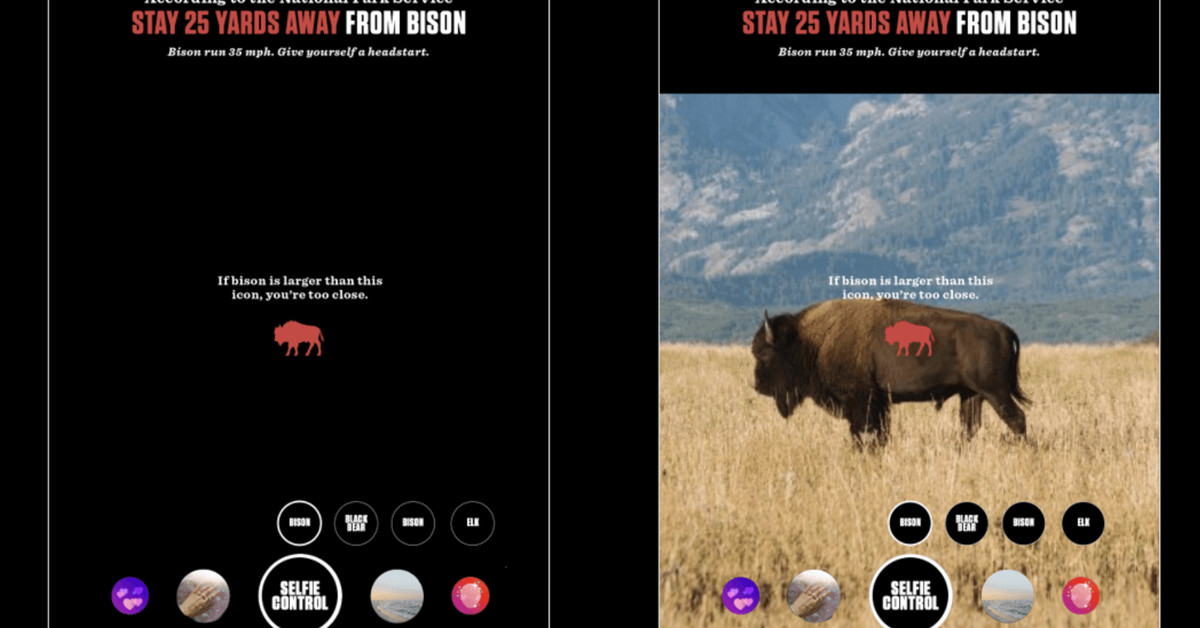Introduction
The Jackson Hole Travel & Tourism Board has developed an innovative solution to help visitors ensure they are maintaining a safe distance from wildlife while taking photos. This open-source Instagram filter, designed specifically for use in Wyoming’s valley and wilderness recreation areas, provides a visual guide that encourages tourism stakeholders to prioritize wildlife protection during the busy summer travel season.
How the Filter Works
The filter operates on the principle of proximity and alignment. Visitors are instructed to identify the type of wildlife they are photographing and then align the animal’s outline within the filter’s icon. If the real-life animal appears larger than the outlined icon, it indicates that the visitor is too close to the subject. In such cases, the visitor should move back until the animal fits within the filter’s guide, ensuring a safe distance for both the animal and the photographer.
Jackson Hole’s Approach
Jackson Hole, like Yellowstone National Park and other wildlife-rich destinations across the United States, plays a crucial role in educating tourists about appropriate wildlife viewing behaviors. The board has established specific guidelines recommending different distances based on the type of animal being observed. For instance, visitors are advised to maintain at least 100 yards of space from bears, while other animals such as moose and deer require closer proximity—at least 25 yards—during photo opportunities.
Related Articles
The Threat of Extinction Growing for Migratory Animals
The alarming rate at which migratory species face extinction has led to widespread concern among conservationists and wildlife enthusiasts alike. Recent studies have highlighted the urgent need for measures that protect these animals while preserving natural habitats. The reintroduction of wolves in Colorado serves as a compelling example of how populations can be revitalized through careful management, offering hope for similar efforts elsewhere.
Introducing the Reintroduction of Wolves in Colorado
The successful reintroduction of wolves in Colorado has brought newfound vitality to the region’s ecosystems. This bold step has not only rejuvenated local wildlife populations but also sparked discussions about the potential benefits of managing other endangered species. The experience from Colorado provides valuable lessons for other areas striving to balance conservation and human activities.
Threats of Extinction
The Declining Health of Bison in Yellowstone National Park
The injuries sustained by visitors at Yellowstone National Park have raised serious questions about public awareness and responsibility towards wildlife. Between 2000 and 2015, bison injured more people than any other animal at this iconic park. A recent study published in the scientific journal One Health revealed that over half of these injuries occurred after individuals got too close to the animals, resulting in serious physical harm.
Introducing Wolves: A New Era for Conservation
The Impact of Wolf Reintroduction on Yellowstone National Park
The reintroduction of wolves into Yellowstone National Park has been a game-changer for the park’s wildlife population. This strategic conservation effort has not only revitalized the ecosystem but also created opportunities for scientists to study and understand wolf behavior in their natural habitat.
Historical Context: Yellowstone’s Wildlife Management
The Story Behind Yellowstone’s Bison Population
Yellowstone National Park is renowned for its diverse wildlife populations, with the bison being one of its most iconic species. According to recent data, Yellowstone now boasts the largest population of bison on public lands in the United States. However, this remarkable achievement comes at a cost—the park’s careful management has had significant implications for visitor safety and wildlife conservation.
Conclusion
The Jackson Hole Travel & Tourism Board’s open-source Instagram filter represents an important step forward in ensuring responsible wildlife viewing. By providing visitors with a clear visual guide, the filter helps promote awareness of appropriate distances and behaviors, ultimately fostering healthier interactions between humans and wildlife. The success of this initiative is a testament to the importance of collaboration between tourism operators and conservationists.
Crista Valentino on Wildlife Safety
Crista Valentino, the executive director of the Jackson Hole Travel & Tourism Board, emphasized the significance of preserving the natural beauty of the area for future generations. "We want to see the numbers of stunning wildlife images on the rise while incidents and accidents steadily decline," she said. Her vision has inspired many in the community to take an active role in promoting wildlife safety and conservation.
Recent Incidents Highlighting the Need for Caution
In recent months, several high-profile incidents have underscored the importance of maintaining a safe distance from wildlife. A visitor at Yellowstone National Park recently suffered injuries after coming into proximity with a bison, resulting in an arrest. This incident, along with others documented across the country, serves as a stark reminder of the potential consequences of ignoring wildlife safety guidelines.
Final Thoughts
The introduction of the Instagram filter by the Jackson Hole Travel & Tourism Board marks a positive step in balancing tourism growth with the preservation of our natural environment. By encouraging visitors to take an active role in maintaining safe distances from wildlife, this initiative not only enhances the visitor experience but also contributes to the long-term sustainability of our shared outdoor spaces.




